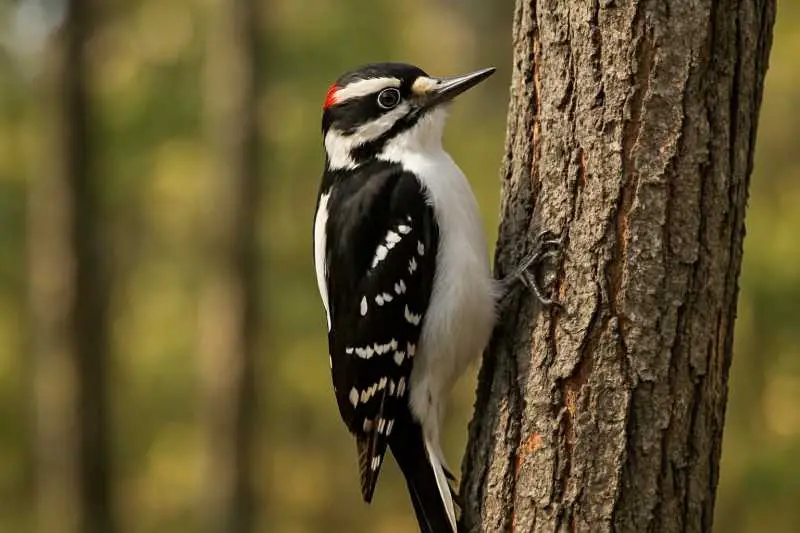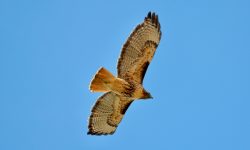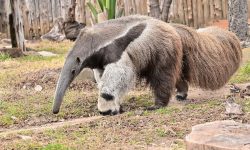Introduction
The Hairy Woodpecker (Dryobates villosus) is one of Alabama’s most common and fascinating woodpeckers. Known for its striking black-and-white plumage and distinctive sharp ‘peek’ call, this bird plays a crucial role in Alabama’s forest ecosystems. In this article, we dive deep into what makes the Hairy Woodpecker unique, focusing on its physical characteristics, behavior, vocalizations, and habitat in Alabama.

Physical Characteristics of the Hairy Woodpecker
Size and Striking Appearance
The Hairy Woodpecker is a beautifully patterned, medium-sized bird, measuring 20 to 26 centimeters (8 to 10 inches) from beak tip to tail. Its bold black-and-white plumage immediately catches the eye, making it one of the most recognizable woodpeckers in Alabama’s forests. The bird’s back is predominantly white, accented by a prominent, clean white stripe running down the center, which contrasts vividly against its solid black wings. These wings are beautifully speckled with crisp white spots and bars, giving the bird a textured, almost checkered look in flight.
A striking sexual dimorphism appears on the head: males proudly display a small but vivid red patch on the back of their heads, adding a splash of color to their monochrome palette, while females have entirely black-and-white heads without any red markings. This subtle difference makes identifying the sexes in the field both fun and rewarding.
The Powerful Bill: A Signature Feature
One of the most distinctive features that sets the Hairy Woodpecker apart from its close cousin, the Downy Woodpecker, is its large, sturdy bill. Unlike the smaller, more delicate bill of the Downy, the Hairy’s bill is long, straight, and almost as long as its head, resembling a precise chisel made for hard work. This powerful bill is perfectly designed for its primary task: boring deep into the tough bark of trees to reach hidden insects and larvae.
Specialized Adaptations for Survival
But the bill is only part of the story. The Hairy Woodpecker’s strong neck muscles and shock-absorbing skull work in harmony to withstand the repeated, rapid pecking required for foraging and communication. Each strike is like a tiny hammer blow, allowing the bird to excavate intricate tunnels beneath the bark or drum loudly on tree trunks — not just for feeding but to mark territory and attract mates.
Its sharp eyesight and agile feet, equipped with sharp claws and stiff tail feathers, allow it to cling vertically to tree trunks and maneuver skillfully as it probes every crevice for food. This combination of physical traits makes the Hairy Woodpecker a true master of its arboreal habitat.
The Distinctive ‘Peek’ Call: Alabama’s Signature Sound
Description of the Call
One of the most captivating traits of the Hairy Woodpecker is its unmistakable sharp ‘peek’ call—a sound that resonates clearly through Alabama’s forests, instantly signaling the bird’s presence. This crisp, staccato note is much more than just a casual chirp; it is a versatile vocal tool the bird uses constantly throughout the day.
Whether calling out to a mate or alerting others to potential danger, the ‘peek’ serves as an essential form of communication. When a predator approaches or an intruder invades its territory, the Hairy Woodpecker’s sharp call transforms into an urgent alarm, warning nearby birds of possible threats.
Defining Territorial Boundaries
Beyond communication, the ‘peek’ call functions as an auditory boundary marker. In the dense woodlands of Alabama, where visual signals are limited by thick foliage, this piercing call helps the Hairy Woodpecker stake out and defend its territory. The repetitive nature of the call sends a clear message to rival woodpeckers: this area is claimed and should not be trespassed.
Vocalization Compared to Other Woodpeckers
When compared to other woodpecker species found in Alabama, the Hairy Woodpecker’s call stands out for its sharpness and clarity. While some woodpeckers produce softer, more rapid or buzzing calls, the Hairy’s ‘peek’ is distinctly piercing and carries effortlessly over long distances — even through dense forest cover. This makes it easier for birdwatchers and naturalists alike to identify the species just by sound, long before the bird is seen.
The iconic ‘peek’ is truly Alabama’s woodland signature, echoing through trees as a perfect example of how nature uses sound to navigate, communicate, and survive.
Habitat and Distribution in Alabama
Preferred Environment
The Hairy Woodpecker is a highly adaptable species that thrives in a variety of habitats across Alabama. However, it shows a clear preference for mature hardwood and mixed forests, where towering oaks, maples, and hickories provide abundant food sources and nesting sites. These older forests offer plenty of standing dead trees and snags — crucial natural features that the Hairy Woodpecker depends on for excavating nest cavities and searching for insect prey beneath the bark.
Interestingly, Hairy Woodpeckers have also adapted well to more urbanized environments. Suburban parks, wooded residential neighborhoods, and even small forest patches within cities can support healthy populations, as long as mature trees and suitable foraging opportunities are available. This ability to thrive near human habitation highlights their remarkable resilience.
Range Within Alabama
The Hairy Woodpecker’s range extends broadly throughout Alabama, from the rolling Appalachian foothills in the northern regions all the way to the humid coastal plains in the south. Wherever mature trees grow, you’re likely to find this industrious woodpecker at work.
This widespread distribution shows the species’ impressive flexibility and ecological success. Despite ongoing development and habitat changes, Hairy Woodpeckers continue to flourish by taking advantage of a mix of natural and human-influenced landscapes, maintaining their vital role in Alabama’s forest ecosystems.
Behavior and Diet
Feeding Habits
The Hairy Woodpecker is an expert forager, primarily dining on a diet rich in insects that hide beneath tree bark. It skillfully probes for ants, beetles, larvae, and other wood-boring insects, using its powerful bill to peel back layers of bark and expose hidden prey. This insectivorous diet plays a crucial role in keeping tree populations healthy by controlling pest outbreaks.
During the colder months, when insect availability drops sharply, the Hairy Woodpecker shows impressive dietary flexibility. It supplements its meals with fruits, nuts, and seeds, including acorns and berries, providing essential energy to survive winter’s scarcity. This adaptability in feeding behavior helps ensure its survival year-round in Alabama’s variable climates.
Nesting and Reproduction
Nesting is a vital part of the Hairy Woodpecker’s life cycle. These birds are talented excavators, creating cozy nest cavities inside dead or dying trees, often repurposing old holes left by themselves or other woodpeckers. These nests provide safe havens from predators and harsh weather.
A typical clutch consists of 3 to 7 eggs, which both the male and female share responsibility for incubating. After hatching, both parents are actively involved in feeding and protecting their young, ensuring the next generation has a strong start.
Conclusion
The Hairy Woodpecker (Dryobates villosus) is more than just a common bird in Alabama’s forests — its sharp ‘peek’ call is a hallmark of the region’s natural soundscape. Its distinctive appearance, specialized behaviors, and adaptability make it a fascinating subject for birdwatchers and an essential contributor to Alabama’s ecological balance.
If you’re exploring Alabama’s woodlands, keep an ear out for that unmistakable ‘peek’ — it might just lead you to one of these remarkable woodpeckers!






